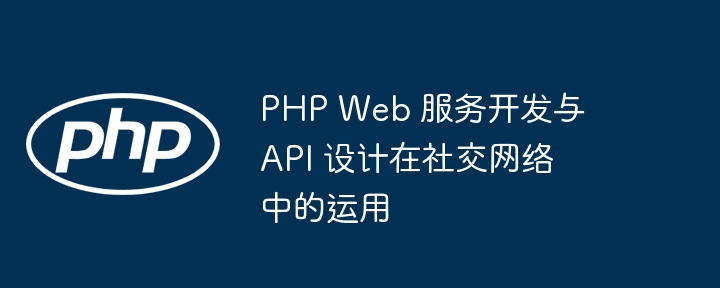Home >Backend Development >PHP Tutorial >Application of PHP Web service development and API design in social networks
Application of PHP Web service development and API design in social networks
- PHPzOriginal
- 2024-05-06 14:39:021205browse
In PHP web services development, web services are used for social networking tasks such as user authentication and status update management, while APIs are used for third-party application integration. PHP supports SOAP web services and RESTful/GraphQL API designs. In the actual case, user registration is carried out through SOAP web services and RESTful API is used to verify user information, demonstrating the application of PHP in social networks.

The application of PHP Web service development and API design in social networks
In today's interconnected world, social networks have become a way for people to socialize, communicate and An important platform for sharing information. PHP, as a widely used web server-side language, plays a vital role in the development of social networks.この记事 will explore the application of PHP web service development and API design in social networks, and illustrate its specific implementation through practical cases.
Web Service Development
Web services are applications built based on the HTTP protocol that can exchange data between different systems or applications over the Internet. In social networks, web services are used to perform various tasks such as:
- User authentication and registration
- Posting and getting status updates
- Managing friend requests and Dynamic
- Sending and receiving messages
PHP provides a complete Web service development framework, including built-in SoapClient and SoapServer classes. These classes allow us to easily create and consume SOAP (Simple Object Access Protocol) web services:
// 创建 SOAP 服务器
$server = new SoapServer('soapservice.wsdl');
// 注册 SOAP 方法
$server->addFunction('sum');
// 响应 SOAP 请求
$server->handle();API Design
API (Application Programming Interface) defines a standardized set of methods and protocols , for other applications to interact with. In social networks, APIs are crucial because they enable third-party applications to access and integrate social network data.
PHP supports the design of RESTful API and GraphQL API. RESTful APIs use HTTP verbs (such as GET, POST, PUT, DELETE) to express operations, while GraphQL is a query language that allows clients to specify the data they want to retrieve from the server.
// 创建 RESTful API 路由
$app = new Slim\App;
$app->get('/users/{id}', 'get_user');
$app->post('/users', 'create_user');Practical Case: User Registration
Let us use a practical case to demonstrate the application of PHP Web service development and API design in social networks. We create a user registration service that uses a SOAP web service to provide registration functionality and a RESTful API to authenticate user information.
SOAP API code:
// 创建 SOAP 服务器
$server = new SoapServer('userservice.wsdl');
// 注册 SOAP 方法
$server->addFunction('registerUser');
// 定义 registerUser 方法
function registerUser($firstName, $lastName, $email, $password) {
// 保存用户到数据库
// ...
// 返回注册成功的 SOAP 响应
return 'Registered successfully';
}
// 响应 SOAP 请求
$server->handle();RESTful API code:
// 创建 RESTful API 路由
$app = new Slim\App;
$app->post('/users', 'validate_user');
// 定义 validate_user 路由处理函数
function validate_user($request, $response, $args) {
// 获取用户信息
$data = $request->getParsedBody();
// 使用 SOAP API 验证用户信息
$result = soap_verifyUser($data['firstName'], $data['lastName'], $data['email'], $data['password']);
// 返回 JSON 响应
return $response->withJson(['valid' => $result]);
}By integrating SOAP web services and RESTful API into In the application, we created a powerful user registration service that can be accessed both through the SOAP client and through the RESTful API from external applications.
The above is the detailed content of Application of PHP Web service development and API design in social networks. For more information, please follow other related articles on the PHP Chinese website!

